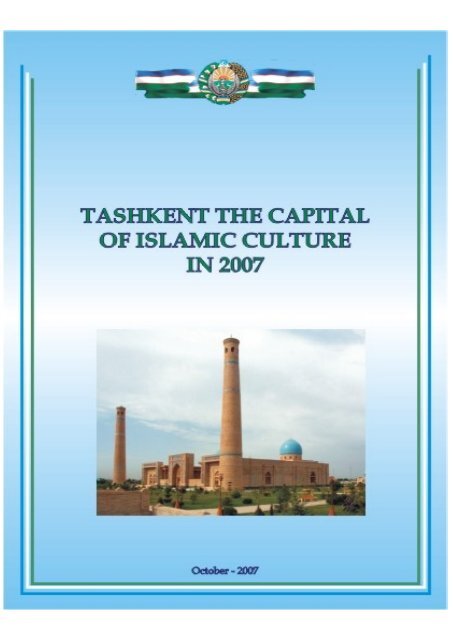Tashkent - the Capital of Islamic Culture in 2007 - Uzbekistan
Tashkent - the Capital of Islamic Culture in 2007 - Uzbekistan
Tashkent - the Capital of Islamic Culture in 2007 - Uzbekistan
You also want an ePaper? Increase the reach of your titles
YUMPU automatically turns print PDFs into web optimized ePapers that Google loves.
<strong>Tashkent</strong> - <strong>the</strong> <strong>Capital</strong> <strong>of</strong> <strong>Islamic</strong> <strong>Culture</strong> <strong>in</strong> <strong>2007</strong><br />
S<strong>in</strong>ce <strong>the</strong> ancient times <strong>Uzbekistan</strong> has been tak<strong>in</strong>g an important place <strong>in</strong><br />
formation <strong>of</strong> human civilization, <strong>in</strong>clud<strong>in</strong>g <strong>the</strong> <strong>Islamic</strong> culture. Its renowned scientists<br />
made an enormous contribution to <strong>the</strong> development <strong>of</strong> various spheres <strong>of</strong> science and<br />
culture.<br />
After ga<strong>in</strong><strong>in</strong>g <strong>in</strong>dependence <strong>Uzbekistan</strong> chose a path <strong>of</strong> rebirth and fur<strong>the</strong>r<br />
improvement <strong>of</strong> rich cultural heritage. At <strong>the</strong> same time, <strong>the</strong> special attention is attached<br />
to <strong>the</strong> study <strong>of</strong> cientific and cultural heritage, refurbishment, restoration and improv<strong>in</strong>g<br />
<strong>the</strong> shr<strong>in</strong>es l<strong>in</strong>ked with <strong>the</strong> names <strong>of</strong> scientists-<strong>the</strong>ologians famous <strong>in</strong> <strong>the</strong> <strong>Islamic</strong> world.<br />
At <strong>the</strong> beg<strong>in</strong>n<strong>in</strong>g <strong>of</strong> this year <strong>the</strong> International <strong>Islamic</strong> Educational, Scientific and<br />
Cultural Organization (ISESCO), which is one <strong>of</strong> <strong>the</strong> <strong>Islamic</strong> Conference Organization’s<br />
structures, has named <strong>Tashkent</strong> a capital <strong>of</strong> <strong>Islamic</strong> culture <strong>in</strong> <strong>2007</strong>.<br />
Alongside with <strong>Tashkent</strong>, which represents <strong>the</strong> Asian cont<strong>in</strong>ent, <strong>the</strong> cities <strong>of</strong> Fes<br />
(Morocco) and Tripoli (Libya), which represent <strong>the</strong> Arab world, and <strong>the</strong> capital city <strong>of</strong><br />
Senegal Dakar, represent<strong>in</strong>g <strong>the</strong> African cont<strong>in</strong>ent, are named <strong>the</strong> capitals <strong>of</strong> <strong>Islamic</strong><br />
culture.<br />
<strong>Tashkent</strong> has been honored to receive such high and honorable rank thanks to<br />
outstand<strong>in</strong>g merits <strong>of</strong> <strong>Uzbekistan</strong> before <strong>the</strong> <strong>Islamic</strong> culture and science, preservation <strong>of</strong><br />
monuments and fur<strong>the</strong>r enrichment <strong>of</strong> <strong>Islamic</strong> heritage.<br />
Before <strong>the</strong> <strong>Islamic</strong> period such cities <strong>of</strong> <strong>Uzbekistan</strong> as Samarkand, Bukhara, Nasaf,<br />
Urgench, <strong>Tashkent</strong> and Margilan were one <strong>of</strong> <strong>the</strong> important political, cultural and tradecommercial<br />
centers not only <strong>in</strong> Central Asia, but <strong>in</strong> <strong>the</strong> entire Orient.<br />
In <strong>the</strong> beg<strong>in</strong>n<strong>in</strong>g <strong>of</strong> <strong>the</strong> 8 th century on <strong>the</strong> territory <strong>of</strong> <strong>Uzbekistan</strong> spread <strong>the</strong><br />
khanafiya branch <strong>of</strong> Islam with its tolerance and liberal views. In <strong>the</strong> beg<strong>in</strong>n<strong>in</strong>g <strong>of</strong> <strong>the</strong><br />
10 th century <strong>Tashkent</strong> became a center <strong>of</strong> development <strong>of</strong> <strong>Islamic</strong> spiritual and secular<br />
culture, where architectural pr<strong>in</strong>ciples were formed, peculiar to Muslim world and<br />
architecture <strong>of</strong> cult character.<br />
S<strong>in</strong>ce <strong>the</strong> 11 th century on <strong>the</strong> territory <strong>of</strong> modern <strong>Uzbekistan</strong> first educational<br />
<strong>in</strong>stitutions <strong>of</strong> Islam – madrassah was established, where religious and secular subjects<br />
were taught.<br />
One <strong>of</strong> <strong>the</strong> outstand<strong>in</strong>g examples <strong>of</strong> merit <strong>of</strong> <strong>the</strong>ologians <strong>of</strong> <strong>Uzbekistan</strong> <strong>in</strong> <strong>the</strong><br />
process <strong>of</strong> development <strong>of</strong> Islam is that <strong>the</strong> authors <strong>of</strong> collection <strong>of</strong> hadises <strong>of</strong> pr<strong>of</strong>it<br />
Mukhammad – Imam al-Bukari (al Jami as Sahih) and Imam at-Termizi (Sunan at-<br />
Termizi), were orig<strong>in</strong>ated from <strong>the</strong> land <strong>of</strong> <strong>Uzbekistan</strong>.<br />
Their works are considered to be <strong>the</strong> true hadise books, which are <strong>the</strong> second<br />
important sources <strong>of</strong> Islam after <strong>the</strong> Wholly Koran.<br />
Moreover, one <strong>of</strong> <strong>the</strong> schools <strong>of</strong> Sunni branches <strong>of</strong> Islam – Moturudiya, was<br />
established by <strong>the</strong>ologian from Samarkand – Abu Mansur al-Motrudi.<br />
Theologians <strong>of</strong> Movarounnahr contributed significantly <strong>the</strong> development <strong>of</strong> <strong>Islamic</strong><br />
law. One <strong>of</strong> <strong>the</strong> founders <strong>of</strong> khanafit school <strong>of</strong> fickh (<strong>Islamic</strong> law) is Burkhonidd<strong>in</strong> al-<br />
Margilani (Al Hidoya). Besides, <strong>the</strong> work by Mukhammad ibn Ismoil al Kaffol-Shoshi<br />
“Usul al-fickh” is considered to be one <strong>of</strong> <strong>the</strong> base <strong>of</strong> shaafit school <strong>of</strong> fickh.<br />
Dur<strong>in</strong>g <strong>the</strong> “Golden century <strong>of</strong> Islam” be<strong>in</strong>g <strong>the</strong> center <strong>of</strong> religious-spiritual and<br />
secular sciences, culture and art land <strong>of</strong> <strong>Uzbekistan</strong> was one <strong>of</strong> <strong>the</strong> well developed areas<br />
<strong>of</strong> Muslim world. Works by Mukhammad <strong>in</strong> Muso al-Khorezmi, Ahmad al-Fargoni,<br />
Mirzo Ulugbek, Abu Ali Ibn S<strong>in</strong>o (Avicenna), Abu Rayhon Beruni served to <strong>the</strong><br />
development <strong>of</strong> not only <strong>Islamic</strong> world, but created <strong>the</strong> base for scientific development <strong>in</strong><br />
Europe <strong>in</strong> <strong>the</strong> 15 th -16 th centuries.
On <strong>the</strong> base <strong>of</strong> <strong>the</strong> works <strong>of</strong> Mirzo Ulugbek own works carried out such wellknown<br />
Muslim scientists as Shamsidd<strong>in</strong> Mukhammad as-Sufiy al-Masriy (Egypt),<br />
Zaynidd<strong>in</strong> al-Javhariy (Syria) Giyosidd<strong>in</strong> ash-Sherazi (Iran), Faridudd<strong>in</strong> Dehlaviy (India),<br />
Mukhammad Chalabi (Turkey) and o<strong>the</strong>rs.<br />
Dur<strong>in</strong>g <strong>the</strong> years <strong>of</strong> Independence scientific and cultural heritage <strong>of</strong> such great<br />
<strong>the</strong>ologians as Imam al Bukhari, Imam at Termezi, Imam Motrudi and Burkhoudd<strong>in</strong><br />
Marg<strong>in</strong>oni were rehabilitated. At <strong>the</strong> same time, numerous mosques and madrassah were<br />
restored and many <strong>of</strong> <strong>the</strong>m are duly acknowledged and highly valued by <strong>the</strong><br />
<strong>in</strong>ternational community.<br />
At present, more than 2.000 mosques, over 10 higher and secondary specialized<br />
religious <strong>in</strong>stitutions are operat<strong>in</strong>g <strong>in</strong> <strong>Uzbekistan</strong>. In particular, <strong>Tashkent</strong> <strong>Islamic</strong> Institute<br />
named after Imam al-Bukhary, Kukeldash Madrassah and <strong>Tashkent</strong> <strong>Islamic</strong> University<br />
established upon <strong>the</strong> <strong>in</strong>itiative <strong>of</strong> <strong>the</strong> President <strong>of</strong> <strong>Uzbekistan</strong> Islam Karimov.<br />
Announc<strong>in</strong>g <strong>Tashkent</strong> as a capital <strong>of</strong> <strong>Islamic</strong> <strong>Culture</strong> ISESCO has taken <strong>in</strong>to<br />
consideration, above all, <strong>the</strong> policies <strong>of</strong> <strong>Uzbekistan</strong>’s Leadership aimed at reviv<strong>in</strong>g <strong>the</strong><br />
cultural and spiritual values <strong>of</strong> Uzbek people, as well as <strong>the</strong> measures taken by <strong>the</strong><br />
Government <strong>of</strong> <strong>Uzbekistan</strong> to protect and carefully preserve <strong>the</strong> monuments <strong>of</strong> <strong>Islamic</strong><br />
civilization.


